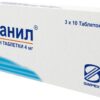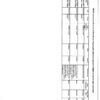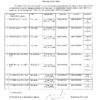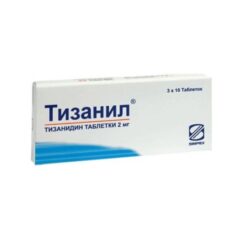No products in the cart.
Tizanil, tablets 4 mg 30 pcs
€7.13 €6.24
Description
By stimulating presynaptic a2-receptors, it suppresses the release of excitatory amino acids that stimulate receptors for N-methyl-D-aspartate (NMDA-receptors). As a consequence, polysynaptic transmission of excitation is suppressed at the level of intermediate neurons of the spinal cord.
Since this mechanism is responsible for excessive muscle tone, when it is inhibited, muscle tone decreases. It also has a central moderately pronounced analgesic effect.
Pharmacokinetics:
It is absorbed quickly and almost completely. Maximum concentration in blood plasma is reached about 1 hour after intake. Because of the pronounced metabolism during “first passage” through the liver, the average bioavailability is about 34%. Binding to plasma proteins is 30%.
The pharmacokinetics of tizanidine is linear in dose range from 4 to 20 mg. The inter-individual variability of pharmacokinetic parameters is low. Gender has no effect on the pharmacokinetics of tizanidine. It is metabolized in liver, mainly by cytochrome P450 system isoenzyme 1A2.
The metabolites are inactive. The elimination half-life is 2-4 hours. It is eliminated mainly by the kidneys as metabolites, a small part of it is eliminated unchanged. Average value of maximum concentration in plasma in patients with renal insufficiency (creatinine clearance less than 25 ml/min) was 2 times higher than in healthy volunteers, and excretion half-life was prolonged up to 14 hours.
Contemporaneous intake of food has no clinically significant effect on the pharmacokinetics of tizanidine.
Indications
Indications
Painful muscle spasm associated with static and functional diseases of the spine, as well as after surgical interventions;
spasticity of skeletal muscles in neurological diseases (multiple sclerosis, chronic myelopathy, degenerative diseases of the spinal cord, cerebrovascular accidents, cerebral palsy (in patients over 18 years of age).
Pharmacological effect
Pharmacological effect
By stimulating presynaptic a2 receptors, it inhibits the release of excitatory amino acids that stimulate N-methyl-D-aspartate receptors (NMDA receptors). As a result, polysynaptic transmission of excitation is suppressed at the level of interneurons of the spinal cord.
Since this mechanism is responsible for excess muscle tone, when it is suppressed, muscle tone decreases. It also has a central moderate analgesic effect.
Pharmacokinetics:
Absorbed quickly and almost completely. The maximum concentration in blood plasma is reached approximately 1 hour after administration. Due to the pronounced first-pass metabolism through the liver, the average bioavailability is about 34%. Plasma protein binding 30%.
In the dose range from 4 to 20 mg, the pharmacokinetics of tizanidine is linear. Interindividual variability of pharmacokinetic parameters is low. Gender does not affect the pharmacokinetics of tizanidine. Metabolized in the liver, mainly by isoenzyme 1A2 of the cytochrome P450 system.
Metabolites are inactive. The half-life is 2-4 hours. It is excreted mainly by the kidneys in the form of metabolites, a small part – unchanged. In patients with renal failure (creatinine clearance less than 25 ml/min), the average maximum plasma concentration was 2 times higher than that in healthy volunteers, and the half-life was extended to 14 hours.
Concomitant food intake does not have a clinically significant effect on the pharmacokinetics of tizanidine.
Special instructions
Special instructions
Cases of liver dysfunction associated with tizanidine have been reported, but these cases are rare at daily doses up to 12 mg. In this regard, it is recommended to monitor liver function tests once a month in the first 4 months of treatment in those patients who are prescribed tizanidine at a daily dose of 12 mg or higher, as well as in cases where there are clinical signs suggesting impaired liver function, such as unexplained nausea, anorexia, and fatigue. In cases where the activity of AST and ALT in the serum consistently exceeds the ULN by 3 times or more, the use of Tizanil should be discontinued.
In patients with congenital long QT syndrome, tizanidine should be prescribed with caution because In preclinical studies of chronic toxicity in animals (dogs), a prolongation of the QT interval was noted when the drug was used at a dose equivalent to the maximum dose for humans.
In patients with coronary heart disease and (or) heart failure, ECG should be regularly monitored.
In patients with myasthenia gravis, it should be used with extreme caution only in cases where the expected benefit significantly outweighs the possible risk.
Impact on the ability to drive a car or perform work that requires increased speed of physical and mental reactions.
If drowsiness, dizziness, or decreased blood pressure develop during Tizanil therapy, you should refrain from activities that require high concentration and quick reaction, such as driving or operating machinery.
Active ingredient
Active ingredient
Tizanidine
Composition
Composition
Each tablet contains 2, 4 or 6 mg of tizanidine as an active substance and
Pregnancy
Pregnancy
Contraindicated in children under 18 years of age (due to insufficient data).
Since there are no controlled studies of tizanidine in pregnant women, it should not be used during pregnancy unless the expected benefit to the mother outweighs the possible risk to the fetus.
Tizanidine passes slightly into breast milk, so the drug should be discontinued during breastfeeding.
Contraindications
Contraindications
Severe liver dysfunction,
hypersensitivity to any of the components of the drug,
simultaneous use with fluvoxamine,
age under 18 years (due to insufficient data),
pregnancy and lactation period.
With caution:
renal failure, old age, simultaneous use with CYP1A2 inhibitors (antiarrhythmic drugs (amiodarone, mexiletine, propafenone), cimetidine, fluoroquinolones, rofecoxib, oral contraceptives, ticlopedine).
Side Effects
Side Effects
Drowsiness, weakness, dizziness, slight decrease in blood pressure, dry mouth, nausea, gastrointestinal disorders, transient increase in the activity of liver transaminases.
When taking the drug in higher doses, additionally, the following may occur: decreased blood pressure, bradycardia, muscle weakness, insomnia, sleep disorders, hallucinations, acute hepatitis (very rare), anxiety.
Interaction
Interaction
Concomitant use of tizanidine with fluvoxamine or ciprofloxacin (inhibitors of the CYP1A2 isoenzyme) leads to a 33-fold increase in the AUC of tizanidine. As a result, a clinically significant and prolonged decrease in blood pressure may occur, leading to drowsiness, weakness and slowing of psychomotor reactions (in some cases, loss of consciousness); prolongation of the QT interval (see “Overdose”).
The simultaneous use of tizanidine with other inhibitors of the CYP1A2 isoenzyme – antiarrhythmic drugs (amiodarone, mexiletine, propafenone), cimetidine, fluoroquinolones (enoxacin, pefloxacin, norfloxacin), rofecoxib, oral contraceptives, ticlopidine.
Antihypertensive drugs increase the risk of a pronounced decrease in blood pressure and bradycardia.
Ethanol and CNS depressants may potentiate the sedative effects of tizanidine; therefore, concomitant use of tizanidine with CNS depressants and/or alcohol is not recommended.
Overdose
Overdose
Symptoms: nausea, vomiting, decreased blood pressure, dizziness, drowsiness, miosis, anxiety, respiratory failure, coma.
Treatment: repeated administration of activated carbon is recommended to remove the drug from the body. Forced diuresis may also speed up the elimination of tizanidine. Subsequently, symptomatic therapy is carried out.
Storage conditions
Storage conditions
In a dry place, protected from light, at a temperature not exceeding 30 °C
Shelf life
Shelf life
3 years
Manufacturer
Manufacturer
Simpex Pharma Pvt. Ltd, India
Additional information
| Shelf life | 3 years |
|---|---|
| Conditions of storage | In a dry, light-protected place at a temperature not exceeding 30 °C |
| Manufacturer | Simpex Pharma Pvt. Ltd. |
| Medication form | pills |
| Brand | #Н/Д |
Other forms…
Related products
Buy Tizanil, tablets 4 mg 30 pcs with delivery to USA, UK, Europe and over 120 other countries.





















